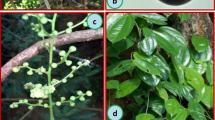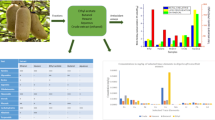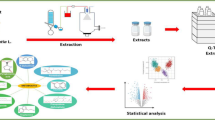Abstract
Bioprospecting of underexplored plants opens up new avenues for developing value added products, ready-to-use herbal formulations and nutraceuticals. This study investigates the volatile metabolome and mineral composition of Haematocarpus validus (Khoon phal), an ethnic fruit crop of tropical Asia. H. validus is used for curing hepatic diseases, anemic and inflammatory conditions in ethnic medicine. Analysis of EI mass spectra on GC–MS platform detected 54 and 48 compounds from fruit and leaf extract respectively. Quinic acid (a hepato-protectant) predominates among volatiles in fruit (29.13%) and unsaturated fatty acids in leaf (61%). Through HP-TLC spectrodensitometric study, quinic acid was quantified as 292.95 mg/100 g dry weight. Five macroelements and 17 microelements were analyzed using ICP–AES and ICP–MS respectively. H. validus fruit has very high K/Na ratio (280.65) and both fruit and leaf are rich in Fe content (57.29 and 38.44 mg/100 g dry weight respectively). High unsaturated fatty acid/ saturated fatty acid ratio and abundance of linoleic acid (55.54% of total fatty acids) in leaf along with relatively high content of conjugated linoleic acid suggest its potential usefulness in pharmaceutical and nutraceutical industry. This is the first report on volatile metabolome of H. validus fruit and leaf.





Similar content being viewed by others
References
Alex BK (2018) Bioprospecting of the wild edible and underutilized plant Haematocarpus validus (Miers) Bakh.f. ex Forman. Ph.D. thesis, Sam Higginbottom University of Agriculture, Technology and Sciences
Alex BK, Koshy EP, Thomas G (2017) Alkaloids of the ethnic fruit crop khoonphal (Haematocarpus validus (Miers) Bakh.f. ex Forman) from Andaman and Nicobar Islands. Int J Curr Microbiol Appl Sci 6(12):2797–2802
Bohra P, Waman AA, Roy TK, Shivashankara KS (2019) Blood fruit (Haematocarpus validus (Miers.) Bakh.f. ex Forman): a novel source of natural food colourant. J Food Sci Technol 57:381–389. https://doi.org/10.1007/s13197-019-04064-2
Calisir S, Haciseferogullari H, Ozcan MM, Arslan D (2005) Some nutritional and technological properties of wild plum (Prunus spp.) fruits in Turkey. J Food Eng 66(2):233–237
Cavalheiro CV, Picoloto RS, Cichoski AJ, Wagner R, de Menezes CR, Zepka LQ, Croce DMD, Barin JS (2015) Olive leaves offer more than phenolic compounds—fatty acids and mineral composition of varieties from Southern Brazil. Ind Crops Prod 71:122–127
Chang SK, Alasalvar C, Shahidi F (2016) Review of dried fruits: phytochemicals, antioxidant efficacies and health benefits. J Funct Foods 21:113–132
Chen S, Oh SR, Phung S, Hur G, Ye JJ, Kwok SL, Shrode GE, Belury M, Adams LS, Williams D (2006) Anti-aromatase activity of phytochemicals in white button mushrooms (Agaricus bisporus). Cancer Res 66(24):12026–12034
Cho AS, Jeon SM, Kim MJ, Yeo J, Seo KI, Choi MS, Lee MK (2010) Chlorogenic acid exhibits anti-obesity property and improves lipid metabolism in high-fat diet-induced-obese mice. Food Chem Toxicol 48(3):937–943
Enamorado-Baez SM, Abril JM, Gomez-Guzman JM (2013) Determination of 25 trace element concentrations in biological reference materials by ICP–MS following different microwave-assisted acid digestion methods based on scaling masses of digested samples. Anal Chem Article. https://doi.org/10.1155/2013/851713
Gammill W, Proctor A, Jain V (2010) Comparative study of high-linoleic acid vegetable oils for the production of conjugated linoleic acid. J Agric Food Chem 58(5):2952–2957
Gurib-Fakim A (2006) Medicinal plants: traditions of yesterday and drugs of tomorrow. Mol Asp Med 27(1):1–93
Haciseferogullari H, Gezer I, Ozcan MM, Asma BM (2007) Post harvest chemical and physical-mechanical properties of some apricot varieties cultivated in Turkey. J Food Eng 79(1):364–373
Harborne AJ (1998) Phytochemical methods. A guide to modern techniques of plant analysis. Springer, Dordrecht
Hua Z, Zhen-Yu W, Xin Y, Hai-Tian Z, Ying-Chun Z, Ai-Jun D (2014) Determination of free amino acids and 18 elements in freeze-dried strawberry and blueberry fruit using an amino acid analyzer and ICP–MS with micro-wave digestion. Food Chem 147:189–194
Imran M, Khan H, Shah M, Khan R, Khan F (2010) Chemical composition and antioxidant activity of certain Morus species. J Zhejiang Univ Sci B 11(12):973–980
Kohno H, Suzuki R, Yasui Y, Hosokawa M, Miyashita K, Tanaka T (2004) Pomegranate seed oil rich in conjugated linolenic acid suppresses chemically induced colon carcinogenesis in rats. Cancer Sci 95(6):481–486
Kumar K, Kumar B, Selvun T, Sajibala B, Jairaj RSC, Mehrotra S, Pushpangadan P (2006) Ethnobotanical heritage of Nicobarese tribe. J Econ Taxon Bot 30:331–348
Liu Z, Feng Z, Yang Y, Jiang J, Zhang P (2014) Acyl quinic acid derivatives from the stems of Erycibe obustifolia. Fitoterapia 99:109–116
McChesney JD, Venkataraman SK, Henri JT (2007) Plant natural products: back to the future or into extinction? Phytochemistry 68(14):2015–2022
NIH (2020) https://ods.od.nih.gov/factsheets/Iron-HealthProfessional/#h2. Accessed 17 July 2020
Park JB (2009) 5-Caffeoyl quinic acid and caffeic acid orally administered suppress P-selectin expression on mouse platelets. J Nutr Biochem 20(10):800–805
Pereira MC, Boschetti W, Rampazzo R, Celso PG, Hertz PF, Rios ADO, Vizzotto M, Flores SH (2014) Mineral characterization of native fruits from the southern region of Brazil. Food Sci Technol 34(2):258–266
Pero RW (2005) Method of preparation and composition of water soluble extract of the bioactive component of the plant species Uncaria for enhancing immune, anti-inflammatory, anti-tumor and DNA repair processes of warm blooded animals. US Patent No. 0176825A1
Pero RW, Lund H, Leanderson T (2009) Antioxidant metabolisim induced by quininc acid. Increased urinary excretion of tryptophan and nicotinamide. Phytother Res 23(3):335–346
Raaman N (2006) Phytochemical techniques. New India Publishing Agency, New Delhi
Rahim MA, Khatun MJM, Rahman MM, Anwar MM, Mirdah MH (2015) Study on the morphology and nutritional status of Roktogota (Haematocarpus validus)—an important medicinal fruit plant of hilly areas of Bangladesh. Int J Minor Fruits Med Arom Plants 1:11–19
Rodriguez MJ, Villanueva MJ, Tenorio MD (1999) Changes in chemical composition during storage of peaches (Prunus persica). Eur Food Res Technol 209:135–139
Sheng Y, Akesson C, Holmgren K, Bryngelsson C, Giampapa V, Pero RW (2005) An active ingredient of Cat’s Claw water extracts, identification and efficacy of quinic acid. J Ethanopharmacol 96(3):577–584
Singh B, Bedi YS (2016) Rediscovery, taxonomic history and extended enumeration of Haematocarpus validusBakh.f.ex Forman (Menispermaceae) to Indo-Myanmar Biodiversity Hotspot. Nat Acad Sci Lett 39(5):383–387
Singh DR, Singh S, Banu VS (2014) Estimation of phytochemicals and determination of betacarotene in Haematocarpus validus an underutilized fruit of Andaman and Nicobar Islands. Eur J Environ Ecol 1:12–15
Stoner DS, Wang LS, Casto BC (2008) Laboratory and clinical studies of cancer chemoprevention by antioxidants in berries. Carcinogenesis 29(9):1665–1674
Sucharova J, Suchara I (2006) Determination of 35 elements in plant reference materials with different Si contents by inductively coupled plasma mass spectrometry: comparison of microwave digestions assisted by three types of digestion mixtures. Anal Chim Acta 576(2):163–176
Wang GF, Shi LP, Ren YD, Liu QF, Liu HF, Zhang RJ, Li Z, Zhu FH, He PL, Tang W, Tao PZ, Li C, Zhao WM, Zuo JP (2009) Anti-hepatitis B virus activity of chlorogenic acid, quinic acid and caffeic acid in vivo and in vitro. Antiviral Res 83(2):186–190
Xiang T, Xiong QB, Ketut AI, Tezuka Y, Nagaoka T, Wu LJ, Kadota S (2011) Studies on the hepatocyte protective activity and the structure-activity relationships of quinic acid and caffeic acid derivatives from the flower buds of Lonicera bournei. Planta Med 67(4):322–325
Zeng K, Thompson KE, Yates CR, Miller DD (2009) Synthesis and biological evaluation of quninic acid derivatives as antiinflmatory agents. Bioorg Med Chem Lett 19(18):5458–5460
Zhang Q, Jiang Y, Toutounchian J, Wilson MW, Morales-Tirado V, Miller DD, Yates R, Steinle JJ (2013) Novel quinic acid derivative KZ-41 prevents retinal endothelial cell apoptosis without inhibiting retinoblastoma cell death through p38 signaling. Investig Ophthalmol Vis Sci 54(9):5937–5943
Acknowledgements
The authors are thankful to the Vice Chancellor, SHUATS, Prayagraj for providing necessary facilities. We acknowledge the technical support provided by Advanced Instrumentation Research Facility (AIRF), JNU, New Delhi for carrying out GC–MS analysis, CEPCI, Kollam, Kerala for facilitating HP-TLC analysis, Sophisticated Analytical Instrumentation Facility (SAIF), IIT Mumbai for ICP–AES and Central Instrumentation Facility (CIF), Kerala University, Kerala for ICP–MS analyses.
Author information
Authors and Affiliations
Contributions
BKA conceived, carried out the experiments and wrote the MS; EPK interpreted results and contributed for writing MS; SJ contributed in designing the work and correction of MS; GT supervised the work and edited the MS.
Corresponding author
Ethics declarations
Conflict of interest
Authors declare that there is no conflict-of-interest.
Additional information
Publisher's Note
Springer Nature remains neutral with regard to jurisdictional claims in published maps and institutional affiliations.
Supplementary Information
Below is the link to the electronic supplementary material.
Rights and permissions
About this article
Cite this article
Alex, B.K., Koshy, E.P., Jacob, S. et al. Wild edible fruit crop Haematocarpus validus (Miers) Bakh.f. ex Forman (Khoon phal): a novel source of nutraceuticals. J Food Sci Technol 59, 168–178 (2022). https://doi.org/10.1007/s13197-021-04997-7
Revised:
Accepted:
Published:
Issue Date:
DOI: https://doi.org/10.1007/s13197-021-04997-7




